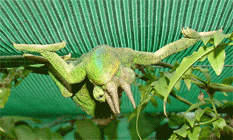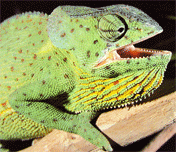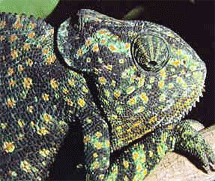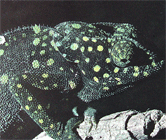Chameleons are probably best
known for their ability to change the colour of their skin, though this
ability is not so much related to the colour of the surface on which
they are standing, for camouflage, which has widely been assumed, but
more on their mood, health and temperature.
Colour changes happen when breeding, excited,
under different lighting conditions, temperature or in the presence of another chameleon.

This male Jacksons chameleon was
hanging upside-down from the shade netting
From about the age of 5 - 6 months chameleons begin to
develop the ability to change colour from the more subtle colours of
dull grays to those that are brighter - green, turquoise and
blue-green.
The colour of their skin changes by the movement of pigments (or
colours) in the skin, and the pigment most responsible for the changes in
colour is melanin.
 Melanin is a dark pigment which is stored in
melanophores, and when the melanin are concentrated in one area inside
the melanophores, the bright yellow and blue pigments can be seen in the
other skin cells (which mixed together make the colour green), and
therefore the chameleon usually looks green. When the dark melanin
spreads out among all the cells they darken and the chameleon appears
to be brown or black, and even sometimes stripped or spotted!
Chameleons can not decided for themselves to change colours, this is
controlled automatically by their hormones and nervous system.


Photos courtesy of 'Chameleons' by Claudia
Schnieper and Max Meier
These are some of the colours into which just one species of
chameleon can change.

Photo courtesy of 'Chameleons' by Claudia
Schnieper and Max Meier
|